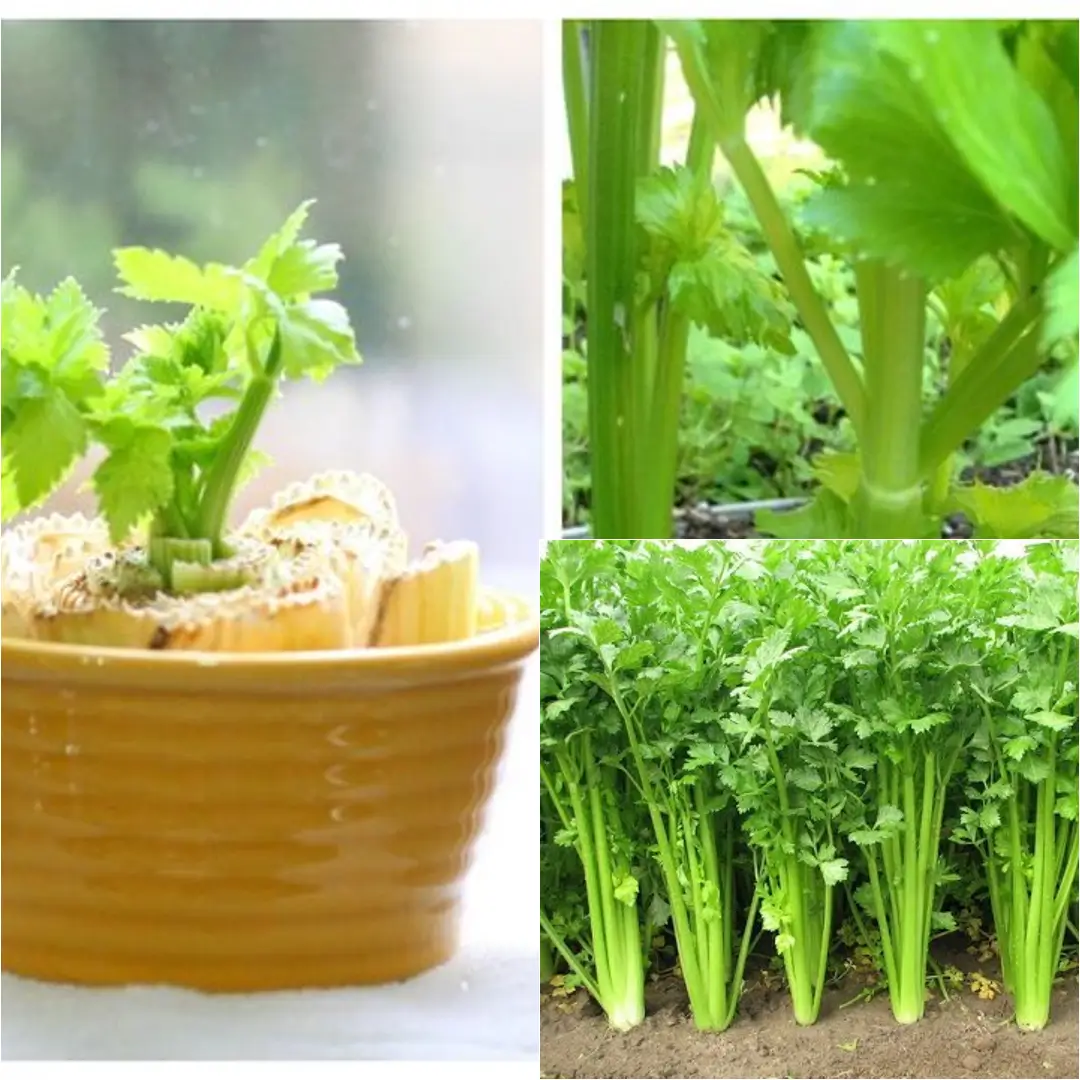To grow celery can be an incredibly rewarding experience, especially when you bite into a fresh, crisp stalk straight from your garden. But let’s face it, celery can be a bit of a diva when it comes to growing conditions. It prefers milder temperatures and a bit of pampering to thrive. So, let’s dive into how to grow celery successfully, ensuring you can enjoy this versatile vegetable in your meals year-round!
Understanding Celery’s Growing Conditions
Celery is quite particular about its environment. Understanding its growing conditions is crucial for ensuring a bountiful harvest.
Ideal Temperatures
Celery prefers milder temperatures—think spring and autumn. Extreme heat or cold can stress the plant and hinder its growth. So, aim for those beautiful, moderate days when the sun isn’t scorching, and the nights are refreshingly cool.
Sunlight Needs
When selecting a location for your celery, look for a spot that receives full sun or, at the very least, morning sun. Celery enjoys basking in the warmth of the sun but also appreciates some shade during the hottest parts of the day.
Soil Requirements
The soil is where the magic happens. Celery thrives in moist but well-drained soil. It’s essential to keep the soil consistently damp, as dry conditions can lead to tough, bitter stalks. You might think of celery like a sponge; it absorbs water but needs a structure that allows for drainage.
When to Plant Celery
Timing is everything when it comes to planting celery. Let’s break it down by regions to ensure you’re planting at just the right time.
Cool and Temperate Regions
If you live in a cool or temperate area, the best time to sow or plant celery is late winter to early spring. This timing allows the celery to take advantage of the cooler weather and establish itself before the summer heat kicks in.
Subtropical Regions
In subtropical climates, the ideal window for planting is mid-autumn to early spring. This allows the celery to flourish during the milder seasons without the stress of high summer temperatures.
Tropical Regions
For those in tropical areas, the dry season, typically from April to July, is the prime time for planting celery. This ensures that the plants have the best chance to grow without the hindrance of excessive rainfall.
Preparing to Grow Celery
Preparation is key to successful gardening. Here’s what you need to do before you plant your celery.
Choosing the Right Spot
Select a garden spot that basks in full sun or at least enjoys the gentle warmth of morning light. A sunny location will help your celery grow robust and flavorful.
Enriching the Soil
Before planting, it’s vital to enrich your soil. Mix in organic matter, such as Scotts Performance Naturals Organic Based Soil Improver and All-Purpose Organic Based Fertiliser. This not only improves soil structure but also provides essential nutrients to your celery plants.
Growing Celery from Seeds
Starting from seeds can be a fun and rewarding process. Here’s how to get those tiny seeds sprouting.
Sowing Seeds
Sprinkle your celery seeds onto the prepared soil or potting mix. Don’t go overboard; a light cover with soil is sufficient. Keep the soil moist—like a damp sponge—until germination occurs.
Optimal Germination Temperature
Celery seeds germinate best at temperatures between 15-20°C. If you find yourself in an area with fluctuating temperatures, you might want to start seeds indoors. Once nighttime temperatures exceed 10°C and seedlings reach about 10-15 cm in height, it’s time to transplant them into the garden.
Growing Celery from Seedlings
If you prefer the ease of using seedlings, follow these steps to ensure healthy growth.
Planting Seedlings
Carefully separate each celery seedling, taking care not to disturb the roots too much. Plant them into your prepared soil or premium potting mix. Space your seedlings about 15-30 cm apart, depending on the variety you choose.
Planting in the Garden
Once your seeds or seedlings are ready, it’s time to get them into the ground.
Sowing and Spacing
Sow your celery seeds or plant seedlings in well-drained soil that you’ve prepared. Be sure to provide ample water, especially as your plants begin to grow. Proper spacing is crucial—keeping plants 15-30 cm apart helps prevent overcrowding and promotes healthy growth.
Blanching for Tenderness
As celery matures, you can “blanch” the stalks to keep them pale and tender. Simply wrap several layers of newspaper around them. This technique helps produce a milder flavor. If you want to skip this step, look for “self-blanching” or stringless varieties, which naturally grow tender stalks without extra fuss.
Planting in Pots
If you’re short on garden space or prefer container gardening, celery can thrive in pots too!
Choosing the Right Pot
Opt for pots that are at least 30 cm wide. Ensure the pot has adequate drainage holes to prevent waterlogging.
Soil and Watering
Fill the pot with Scotts Performance Naturals Premium Organic Based Potting Mix and ensure that the soil stays moist throughout the growing season. This will help your celery develop into those crispy stalks you crave.
Harvesting Celery
The moment you’ve been waiting for—harvesting your celery! Here’s how to do it right.
When to Harvest
You don’t need to harvest the entire plant at once. Instead, you can start picking individual stalks when they reach the thickness of a pencil.
How to Harvest
To harvest, gently pull the stalks from the outside of the plant using a down and out motion. This technique helps you get what you need without damaging the main plant, allowing it to continue producing for weeks.
Managing Pests and Diseases
Like all crops, celery can be susceptible to pests and diseases. Here’s how to keep your plants healthy.
Common Pests
Slugs and snails are notorious for munching on celery stalks and leaves. To protect your plants, set up beer traps (simple saucers filled with beer) or use Defender Snail & Slug Pellets to deter these pesky critters.
Growing celery may seem challenging at first, but with the right conditions, preparation, and care, you can enjoy a flourishing crop. Remember, to successfully grow celery, it thrives in milder temperatures and needs consistent moisture. Whether you choose to start from seeds or seedlings, the rewards of having fresh celery at your fingertips are well worth the effort. So grab your gardening gloves, prepare your soil, and get ready to enjoy the crisp, refreshing taste of homegrown celery!
Now that you know how to grow celery, what are you waiting for? Get planting, and soon you’ll be harvesting your own fresh stalks for soups, snacks, and salads. Happy gardening!
FAQs
1. How long does it take to grow celery?
Growing celery typically takes about 90 to 120 days from seed to harvest. The exact time can vary depending on the variety and growing conditions. Once you start to grow celery, you’ll generally see germination within 2 to 3 weeks after planting. After that, it takes several more weeks for the plants to grow and mature before they are ready for harvest.
2. How do you grow celery from fresh celery?
You can easily grow celery from the base of fresh celery stalks you buy at the store. Here’s how:
- Cut the Base: Take a bunch of celery and cut off the base (about 2-3 inches) from the bottom of the stalks.
- Water Soak: Place the celery base in a shallow dish with enough water to cover the bottom but not fully submerge it.
- Sunlight: Place the dish in a sunny spot and change the water every few days to keep it fresh.
- Transplanting: After about a week, you’ll see new shoots growing. Once they reach 3-4 inches tall, you can transplant the celery into the garden or a pot with soil, burying the base in the soil and leaving the tops exposed.
3. Where does celery grow best?
Celery grows best in cool, temperate regions with rich, moist, and well-drained soil. To effectively grow celery, it prefers a location that receives full sun or at least partial shade. Celery is also sensitive to extreme temperatures, so areas with milder conditions—particularly during the growing season—are ideal. Good drainage is essential to prevent waterlogging, which can lead to root rot.
4. Does celery need a lot of sun to grow?
Yes, celery does need plenty of sunlight to thrive, ideally requiring 6 to 8 hours of full sun per day. However, it can tolerate partial shade, especially in hotter climates, where too much direct sunlight can cause stress to the plants. To successfully grow celery, a balance of sun and shade is crucial for producing tender, flavorful stalks. Aim for a location that provides bright light without scorching heat during the peak of summer.


